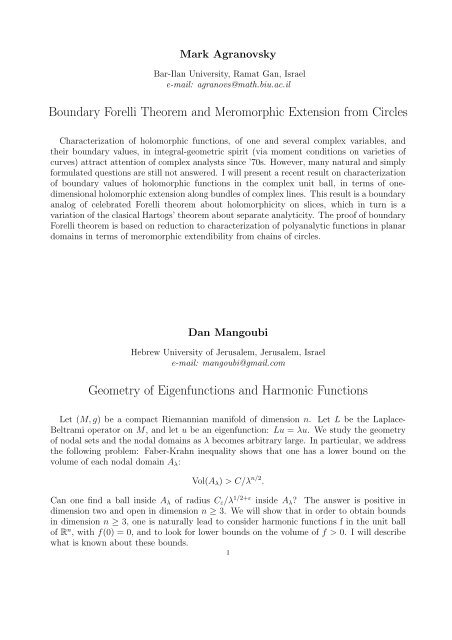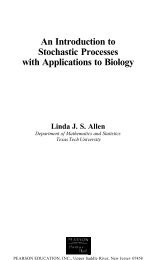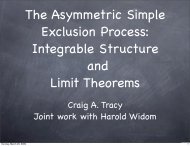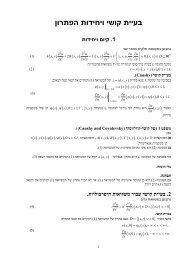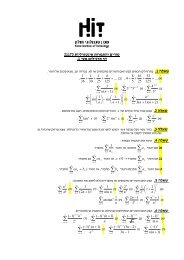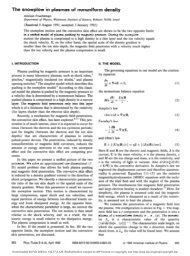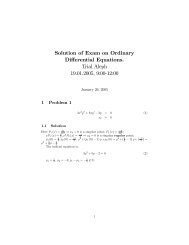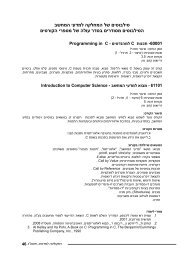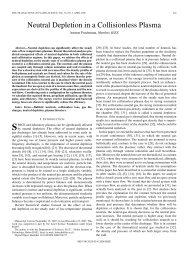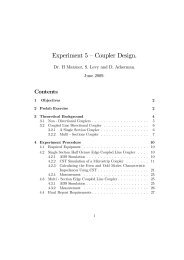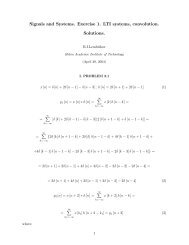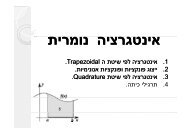Mark Agranovsky, Bar-Ilan University, Ramat Gan, Israel Dan ...
Mark Agranovsky, Bar-Ilan University, Ramat Gan, Israel Dan ...
Mark Agranovsky, Bar-Ilan University, Ramat Gan, Israel Dan ...
Create successful ePaper yourself
Turn your PDF publications into a flip-book with our unique Google optimized e-Paper software.
<strong>Mark</strong> <strong>Agranovsky</strong><br />
<strong>Bar</strong>-<strong>Ilan</strong> <strong>University</strong>, <strong>Ramat</strong> <strong>Gan</strong>, <strong>Israel</strong><br />
e-mail: agranovs@math.biu.ac.il<br />
Boundary Forelli Theorem and Meromorphic Extension from Circles<br />
Characterization of holomorphic functions, of one and several complex variables, and<br />
their boundary values, in integral-geometric spirit (via moment conditions on varieties of<br />
curves) attract attention of complex analysts since ’70s. However, many natural and simply<br />
formulated questions are still not answered. I will present a recent result on characterization<br />
of boundary values of holomorphic functions in the complex unit ball, in terms of onedimensional<br />
holomorphic extension along bundles of complex lines. This result is a boundary<br />
analog of celebrated Forelli theorem about holomorphicity on slices, which in turn is a<br />
variation of the clasical Hartogs’ theorem about separate analyticity. The proof of boundary<br />
Forelli theorem is based on reduction to characterization of polyanalytic functions in planar<br />
domains in terms of meromorphic extendibility from chains of circles.<br />
<strong>Dan</strong> Mangoubi<br />
Hebrew <strong>University</strong> of Jerusalem, Jerusalem, <strong>Israel</strong><br />
e-mail: mangoubi@gmail.com<br />
Geometry of Eigenfunctions and Harmonic Functions<br />
Let (M, g) be a compact Riemannian manifold of dimension n. Let L be the Laplace-<br />
Beltrami operator on M, and let u be an eigenfunction: Lu = λu. We study the geometry<br />
of nodal sets and the nodal domains as λ becomes arbitrary large. In particular, we address<br />
the following problem: Faber-Krahn inequality shows that one has a lower bound on the<br />
volume of each nodal domain A λ :<br />
Vol(A λ ) > C/λ n/2 .<br />
Can one find a ball inside A λ of radius C ε /λ 1/2+ε inside A λ ? The answer is positive in<br />
dimension two and open in dimension n ≥ 3. We will show that in order to obtain bounds<br />
in dimension n ≥ 3, one is naturally lead to consider harmonic functions f in the unit ball<br />
of R n , with f(0) = 0, and to look for lower bounds on the volume of f > 0. I will describe<br />
what is known about these bounds.<br />
1
Alexander M. Olevskii<br />
Tel Aviv <strong>University</strong>, Tel Aviv, <strong>Israel</strong><br />
e-mail: olevskii@yahoo.com<br />
Wiener’s ”Closer of Translates” Problem<br />
and Piatetskii-Shapiro Uniqueness Phenomenon<br />
Wiener characterized cyclic vectors (with respect to translations) in l p (Z) and L p (R) (p =<br />
1, 2) in terms of zero sets of Fourier transform. He conjectured that a similar characterization<br />
should be true for 1 < p < 2. I will discuss this conjecture.<br />
Joint work with Nir Lev.<br />
2<br />
Yosef Yomdin<br />
Weizmann Institute of Sciences, Rehovot, <strong>Israel</strong><br />
e-mail: yosef.yomdin@weizmann.ac.il<br />
Invisible Sets for Integral Measurements<br />
and Moment vanishing Problem<br />
The problem of reconstruction of semi-algebraic sets and functions from integral measurements,<br />
like moments or Fourier transform, naturally arises in Signal Processing. For<br />
certain (incomplete) measurements there are ”invisible” signals. Their description leads<br />
to the moment vanishing problem: give conditions for identical vanishing of the moments<br />
m k = ∫ P k (x)q(x)dx, for various classes of P and q, and various integration domains. Recently<br />
a serious progress has been achieved in some special cases of this problem, and relations<br />
have been found with the Mathieu conjecture in representations of compact Lie groups,<br />
and (through the recent work of Wenhua Zhao) with certain questions around the Jacobian<br />
conjecture.


